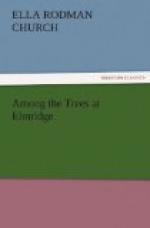“The poplar,” continued Miss Harson, “has a great many insect enemies, and the Lombardy is not often seen now, because a great many of these trees were destroyed on account of a worm, or caterpillar, by which they were infested. Poplar-wood is soft, light and generally of a pale-yellow color; it is much used for toy-making and for boarded floors, ’for which last purpose it is well adapted from its whiteness and the facility with which it is scoured, and also from the difficulty with which it catches fire and the slowness with which it burns. A red-hot poker falling on a board of poplar would burn its way without causing more combustion than the hole through which it passed.’”
“I should think, then,” said Malcolm, “that all wooden things would be made of poplar.”
“It is generally thought not to be durable,” was the reply, “but it is said that if kept dry the wood will last as long as that of any tree. Says the poplar plank,
“’Though
heart of oak be ne’er so stout,
Keep me dry and I’ll
see him out.’
“The poplar has been highly praised, for every part of this tree answers some good purpose. The bark, being light, like cork, serves to support the nets of fishermen; the inner bark is used by the Kamschadales as a material for bread; brooms are made from the twigs, and paper from the cottony down of the seeds. Horses, cows and sheep browse upon it.
“And now,” said Miss Harson, when the children were wondering if that were the end, “we have come to the most interesting tree of the whole species—the aspen, or trembling poplar. It is a small, graceful tree with rounded leaves having a wavy, toothed border, covered with soft silk when young, which remains only as a fringe on the edge at maturity, supported by a very slender footstalk about as long as the leaf, and compressed laterally from near the base. They are thus agitated by the slightest breath of wind with that quivering, restless motion characteristic of all the poplars, but in none so striking as this. ’To quiver like an aspen-leaf has become a proverb. The foliage appears lighter than that of most other trees, from continually displaying the under side of the leaves.
“The aspen has been called a very poetical tree, because it is the only one whose leaves tremble when the wind is apparently calm. It is said, however, to suggest fickleness and caprice, levity and irresolution—a bad character for any tree. The small American aspen, which is quite common, has a smooth, pale-green bark, which gets whitish and rough as the tree grows old. The foliage is thin, but a single leaf will be found, when examined, uncommonly beautiful. A spray of the small aspen, when in leaf, is very light and airy-looking, and the leaves produce a constant rustling sound. ’Legends of no ordinary interest linger around this tree. Ask the Italian peasant who pastures his sheep beside a grove of Abele why the leaves of these trees are always trembling in even the hottest weather when not a breeze is stirring, and he will tell you that the wood of the trembling-poplar formed the cross on which our Saviour suffered.’”




